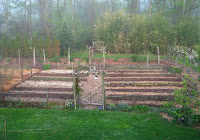It’s time to prune trees and shrubs!! I will be holding a PRUNING WORKSHOP at my garden (in New York's Hudson Valley) on April 10th from 2-5:30 pm. Learn the tools of the trade, how plants respond to pruning, and watch Lee demonstrate pruning of apple trees, blueberry bushes, lilac bushes, and other plants. Limited space, so pre-registration is necessary. The cost is $35 per person with pre-registration before April 6th, $40 otherwise. Contact me for registration information.
-----------------------------
As the writer of the book Weedless Gardening, I would have expected my own vegetable garden to be more weedless. I see weeds in my garden, more than in springs past.
Last summer’s wet weather has something to do with the present weed situation. In a normal summer, with its periods of dryness, drip irrigation (part of my “weedless” gardening system) pinpoints water to my garden plants without promoting weed growth in paths and between widely spaced plants. Incessant rain kept promoting lush growth everywhere.
The clear plastic tunnels that I put up to extend the harvest season of endive, lettuce, and other greens late into autumn also contributed to the present weed situation. Garden plants weren’t the only plants that thrived in those mini-greenhouses. Weeds also were able to sneak in and get some foothold.

In fact, the weed situation is not really that bad. The other day I cleared five beds, each about 3 feet wide and 20 feet long in less than an hour. I started at one end of each bed pulling out each weed along with any remains, now dead, of last autumn’s garden plants. One bed had a lot of little weeds that had sprouted. Rather than pull them individually, I decapitated them en masse by skimming just a half-inch or so beneath the surface of the ground with my sharp winged-weeder. Those small weeds are too small to re-sprout from root pieces.
Important in “weedless gardening” is not tilling the soil, which keeps weed seeds, inevitably present in any soil, from being exposed to the light that they need to sprout. By not having to till the soil and by thoroughly clearing beds of weeds and old plants, the beds are immediately ready for planting– as soon as the ground warms.
-------------------------------------------
Actually, I have one more important task to do before planting any vegetables, and that is the annual mapping out of the garden, something I generally put off as long as possible.

In theory, mapping out my garden should be easy. I “rotate” what I plant in each bed so that no vegetable, or any of its relatives, grows in a given bed more frequently than every 3 years. Crop rotation prevents buildup of pests. So one year a bed might be home to cucumbers (or its kin melons or squashes), the next year that bed might host cabbage (or broccoli, kale, Brussels sprouts, or cauliflower), and the next year tomatoes (or peppers, potatoes, or eggplants), and then back to cucumbers. Beans and peas are another family of vegetables. Simple enough.
It would also be nice to rotate carrots and other root vegetables with leafy vegetables, such as lettuce, and fruiting vegetables, such as tomatoes. Root, leafy, and fruiting vegetables have somewhat different nutrient needs, so in the ideal garden these crops are rotated to make best use of soil nutrients.
And I do like to get the most out of my garden and confuse potential insect pests by grouping different kinds of plants within a bed.
Are you beginning to understand why I put off committing my garden plan to paper each spring?
--------------------------------------------
Peas present one more wrinkle in my vegetable garden planning. A few years ago they stopped bearing well, collapsing with yellowing foliage not long after they bore their first pods.
Further investigation has narrowed the problem to – probably – one of two diseases: fusarium or aphanomyces. Both, unfortunately, are long-lived in the soil so that 3 year rotation does nothing to keep them in check. My tack is to plant some peas in a new location outside my existing vegetable gardens and, for fusarium, to use resistant varieties such as Green Arrow, Little Marvel, Bounty, and/or Daybreak.

Unfortunately, the problem is more likely aphanomyces, for which resistant varieties do not exist. Aphanomyces is a water mold, so thrives under wet conditions. So my tack will also be to keep any peas planted in my vegetable garden on the dry side, not even turning on the drip irrigation in those beds.
I’ll also be checking the plants more closely for symptoms. Plants infected by fusarium have a red discoloration to their roots. Plants infected by aphanomyces have fewer branch roots and what roots there are lack the plump, white appearance of healthy roots.

No comments:
Post a Comment